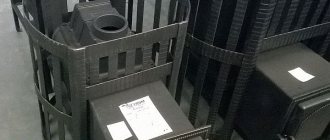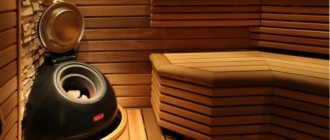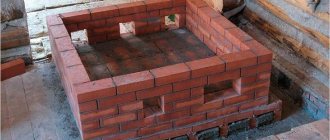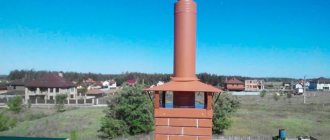The correct choice of chimney pipe design can determine the future fate of the steam room and the entire bathhouse building as a whole. Whether it is stainless steel, brick, or the now fashionable ceramic chimney for a bath, there are many options, but not all of them are equal and equally convenient. The correct design determines how quickly the sauna stove will flare up, and, first of all, how safe the chimney pipe will be for those who like to take a steam bath.
Sometimes a ceramic chimney cannot be distinguished from a brick version
Selection and installation of pipes in the bathhouse
A comfortable microclimate in a bathhouse depends on how correctly the chimney is installed.
After all, a pipe for a bathhouse is not only a means of removing carbon monoxide, but also fire safety and the health of people in the room. Stainless steel pipes for sauna stoves
The device itself can be installed with your own hands; there is nothing complicated in the process. The main thing is to prepare properly: choose the right material and follow all installation recommendations.
Deciding on the parameters
The diameter of the chimney pipe is determined directly based on the instructions supplied with the stove. In most cases, they provide recommendations on recommended pipe diameters.
Information. If there are no instructions, then you need to navigate by the outlet pipe of the furnace.
The instructions also describe the recommended height of the chimney, but if there are no instructions, then install a chimney with a height of at least 450 cm.
Among other things, the following basic rules should be taken into account:
- The chimney pipe can be at least 50 cm higher than the level of the roof ridge. The minimum distance between the ridge and the chimney is 150 cm;
- If your bathhouse has a flat roof, then the chimney pipe should protrude at least 100 cm;
- The maximum distance between the ridge and the pipe is 300 cm.
Choosing material for the chimney
The stove pipe in the steam room can be made of various materials, but it is most advisable to opt for stainless steel products. Important characteristics that allowed stainless steel chimneys to become widespread:
- High temperature resistance;
- The structural elements are lightweight, which simplifies DIY installation;
- Resistance to condensation;
- Resistance to aggressive environments (various acids that make up carbon monoxide);
- Good traction thanks to the perfectly round cross-section;
- No accumulation of soot on the internal walls of the chimney;
- Easy to operate;
- Affordable price.
Chimney for a bathhouse made of stainless steel
Installation of asbestos-cement pipes is undesirable, since they do not meet fire safety standards for a bathhouse. When exposed to high temperatures, they can collapse and thereby cause a fire in the room. The result is dubious savings with health risks.
A ceramic chimney is a reliable and durable design that can withstand temperatures up to 600 degrees, but it is not suitable for a bathhouse. This is due to the excessive weight of the device, which only a capital building can withstand.
Stainless steel is the best choice of material for a sauna smoke exhaust. Reliability, durability, ease of installation with your own hands - these are its main trump cards.
Performing device isolation
Installing a stainless steel chimney with your own hands is very simple - you just need to connect the elements in series from the bottom up. Manufacturers of modular stainless steel systems provide a bell at the end of all component parts. It is also necessary to ensure that all elements that go outside have high-quality thermal insulation. The easiest way is to select ready-made modular “sandwich” elements for installation on the street, as well as in places where the roof or wall passes through.
You can make insulation yourself. To do this, the chimney must be wrapped with a layer of basalt wool, and an external contour made of any metal must be installed on top; the cheapest option is galvanization. Essentially, you need to make a homemade sandwich.
Properly performed thermal insulation is necessary for the following purposes:
- Reducing the temperature of the outer pipe;
- Reduced risk of condensation;
- Acceleration of the pipe heating process;
- Increased traction.
Briefly about the main thing
The main questions when choosing a pipe for a bathhouse are which one is better, safer, more practical, cheaper, more durable. Each owner has his own requirements, so their choice may vary. First you need to decide where the chimney will be installed - inside or outside, and then select it based on the material it is made of. The most practical and durable option is ceramics, but it is also the most expensive. The cheapest pipe is made of ferrous metal, but it is susceptible to corrosion. The optimal solution is a modular chimney made from a sandwich pipe. Regardless of the type of pipe chosen, it is necessary to calculate its diameter and length and select component materials for installation and insulation.
| Additionally The exhibition of houses “Low-Rise Country” expresses sincere gratitude to the staff for their help in creating the material. Schiedel is a leading global manufacturer and supplier of chimney, stove and ventilation solutions, with over 70 years of experience in the field. If you need more detailed advice or a free estimate, you can use the following contacts: Website: schiedel.com email: tel.: +7 (499) 271-30-74 tel.: +7 (499) 271-30-75 |
Ratings 0
Read later
Organization of passage through the roof
The most critical stage of installation is the passage through the roof. After all, cutting a hole in the roof of the steam room can disrupt the hydro- and thermal insulation of the roofing pie, resulting in leaks and destruction of the rafters of the building. Following these recommendations will help you make the right passage through the roof:
- The hole on the roof must be designed in such a way that the distance between its walls and the pipe is about 10-13 cm.
- Make a wooden box on the roof in the place where you plan to install the chimney.
- Fill the entire space that separates the chimney from the inner duct with non-combustible material. In this case, stone wool is suitable.
- Press the waterproofing layer with sheathing bars.
For proper waterproofing, small cracks in the roof can be sealed with silicone-based sealant. Larger cracks can be sealed by installing a special element - a passage, which is located at the point of exit through the roof.
Chimney passage through the roof
The roof passage is an apron-cap, which consists of a steel base and a rubber tip.
The passage is put on the pipe and securely fixed to the roof. Too much effort when shrinking the apron onto the pipe is not required; it can break the tightness of the connection and cause a roof leak.
Examination
To check how well the thermal insulation layer is laid, you need to light the stove.
For diagnostics it is better to use a thermal imager. The optical-electronic system will help determine the sealing quality of the outer casing. With proper installation of the wall of the chimney structure, the seams at the joints do not allow heat to pass through. The places where the heat flow leaks will be indicated by the device screen. Incomplete sealing leads to overheating of the insulating material. If a problem is detected, the outer casing is dismantled and re-insulated. If, after insulating the chimney structure, condensation continues to form on the walls, the heat insulator is selected incorrectly, and the thickness does not meet the established standards. The minimum size is 4 cm. For steel and asbestos pipes with a height of 6 m or more, insulation with a thickness of 10 cm is selected. In brick chimneys, slabs with a thickness of 8 cm are used.
Insulation work should be carried out after the installation of the chimney system and ventilation elements is completed. When installing chimneys, it is necessary to use modern types of insulating materials. It is better to use finished products with thermal insulation.
Cleaning a stainless steel chimney
No matter how good the material used to make a chimney is, there will come a time when it becomes necessary to clean it. To carry out continuous cleaning of the smoke channel, you can use various methods:
- Clean the pipe mechanically using a specially designed brush.
- Using chemical cleaning agents.
- Cleaning the chimney is a simple but effective method - pour boiling water, and then heat the stove for a long time to separate the soot.
Types of smoke exhaust structures
The chimney for a steam room can be external or internal. In our country, you can often find internal options. Among their advantages is the absence of violation of the architectural style, as well as saving heat in the room.
External systems are more like American traditional chimneys. They were previously used by Americans on their ranches. They have a rather interesting appearance. If you decide to build an external solution, then there is no need to make a hole in the roof and ceiling, which definitely has advantages. The wall for the chimney inside must be no less than 12 cm thick, and for the outer wall the thickness must be at least 38 cm.
Popular schemes for installing sauna chimneys
How is the smoke exit structure arranged? Any element is a structure made of pipes, flanges, and fasteners. The main requirement for this building is the ability to operate at high temperatures without any changes in the properties and emissions of combustion products.
To prevent the chimney for a bathhouse from losing large amounts of heat, it is located as close as possible to the inner wall.
When there is more than one stove in a steam room or bathhouse, then each of them must be equipped with its own chimney. Otherwise, the thrust will lose strength. Smoke exhaust system specialists recommend the following. In cases where it is impossible to build several systems for stoves, a cutting system must be installed at a height of approximately 75 cm. It is also important to ensure that the inner surface of the future chimney is as smooth as possible. If there are any roughness inside, soot will accumulate on the walls. This may increase the risk of fire.
Video description
This video contains complete information about the installation of a UNI chimney, the blocks of which are manufactured in Russia:
Among similar products, it is worth noting the products of such joint ventures as:
- Shidel;
- Wolfshäuer;
- Ecoosmosis;
- Hymen.
But if you prefer completely imported products, then they are represented on our market by the following companies:
- Tona (Germany);
- Marshal (Czech Republic);
- Effe 2 (Italy).
The simplest chimney
This element will be based on a stainless steel pipe. In addition to this, you need to prepare one elbow with a diameter of 20x120 cm from galvanized steel, two elbows of 16x120 cm each, three of stainless steel of 16x10 cm each. You will also need a tee with a diameter of 16 cm and a plug for it. You also need a fungus that is the right size. The diameter of the chimney for the bathhouse in this particular case will be 16 cm.
The prepared pipes should be connected to each other using self-tapping screws.
The section of pipe that will be outside is wrapped with basalt wool. The layer should be approximately 16 cm. You should also additionally wrap the cotton wool with asbestos cord. Then a pipe with a diameter of 20 cm is connected, which is fixed and thoroughly coated with bitumen mastic. An asbestos cord is placed in the gap between the two pipes. This is necessary for protection from rain.
This is how you can independently design and install stainless chimneys for a bathhouse. This is a very affordable solution.
Elements of the chimney system
The main part of the chimney system is the stove pipe. There are 3 types with different sizes - 250, 500, 1000 mm in diameter.
The next element of the system is the throttle valve. It is used to adjust traction. It is a pipe with a built-in butterfly valve and an outward handle.
For installation you will also need tees, a cover, thermal insulation, a condensate collector, connections, an ash pan, special adapters, and various protective elements. Some of them are mandatory, while others serve as an addition to the combustion product removal system.
Installation of chimneys for a bathhouse for a metal stove
After the installation of the stove is completed, you can immediately begin installing the chimney. The first step is to attach several expansion supports to the pipe. It’s good if these are pipes made of asbestos or “Sandwich”. The latter can withstand significantly higher temperatures, unlike other analogues. However, such a pipe should not be exposed to direct flame. That is why a steel pipe is installed first, and then, after the first bend, a sandwich or asbestos-cement structure is installed.
Now all that remains is to organize the protection of the upper part from the rain. A plug may be suitable for this. Another one is mounted on the pipe below, which will then facilitate the process of draining condensate and cleaning.
If the oven is brick
This chimney for a bathhouse is easy to build with your own hands. When the row of masonry covers the stove, the construction of the chimney system begins.
So, on the 21st row of brickwork it is necessary to form two channels. They will then be merged. Next, on the right you should block the space above the core. The gap between the core and the masonry will be 2-3 cm. Any voids are filled with mineral wool insulation. With the 22nd row of masonry, the opening will already be closed, and after that you can begin to lay and shift the channels to the middle. To prevent this ceiling from cracking in the future, it is advisable to lay another row of masonry above the stove core.
Next, the chimney will begin to narrow. Valves are installed here. They are made one above the other. Now the brickwork will go into fluff.
For those who have managed to build a brick oven, making a chimney will not be difficult. The main thing is that no cracks arise. Also, the standard for the cross-section of the pipe should not be exceeded. Otherwise, the gases will cool quickly.
How to make a chimney for a bath through the ceiling
Often modern baths are built from pine. This wood sometimes overheats. The process of smoke passage must be created with maximum attention. The wall must be fenced with any non-combustible materials. You can strip steel sheets; mineral wool or brickwork will also work.
Another effective method of protection is a special ceiling-passage assembly.
At the next stage, the pipe is erected above the roof. Its height must be at least 1.5 m. When it passes through the roof covering, it is necessary to apply a sealing cover. Using this operation, you can hermetically connect the chimney pipes.
In order to get good traction and long service life, you need to clean the pipe from accumulated soot and debris once every six months. And then the bathhouse will delight its owner for a very long time.
Where to place
Chimney pipes for a bathhouse can be placed both inside and outside. Each of the methods has both disadvantages and advantages.
External method
This method is simpler than the internal one, since it does not require wires through the ceiling and roof; it is enough to just bring the pipe out through the wall.
The external chimney structure is safer because it does not come into contact with roofing and ceilings.
In addition, in this case there is no need to install safe insulating transitions.
The disadvantage of this option is the need for extensive insulation of the pipe, since condensation will inevitably appear inside it.
Due to the fact that the heat from the pipe is not used to heat the room, fuel consumption increases.
Arrangement of the internal structure
In this case, the chimney pipe is installed on top of the sauna stove, rises to the ceiling and is passed through the attic and roofing floors.
This design allows the pipe to transfer all the heat to the room, which will significantly save on heating costs. In addition, the oven will take longer to cool down, and the formation of condensation will be reduced to zero.
A significant disadvantage is the need to wire the pipe through the structural elements of the bathhouse, since this is quite difficult, expensive and not always safe.
However, if you properly arrange all the passage units, as well as joints and connections, the chimney will serve uninterruptedly for a long time.
Bath pipes
The chimney plays a very important role in creating a comfortable microclimate. The choice of pipe material for it is also important. A chimney is not only a smoke exhaust system, but also safety in case of fire, as well as health. Let's find out which chimneys are best for a bathhouse.
The pipe in the steam room can be made from a variety of materials. However, it is best to use stainless steel for this. This material has a lot of important characteristics, such as resistance to high temperatures, light weight, ease of use, good traction, and resistance to aggressive environments. The best chimney for a bathhouse is made of stainless steel.
Asbestos cement pipes are not very desirable. They poorly comply with fire safety standards.
Ceramics are reliable and durable. Such chimneys can withstand high temperatures up to 600 degrees. But these pipes are also poorly suited for a bathhouse. It's all due to the heavy weight. They are definitely not suitable for wooden structures.
This is a modern option. Chimneys for wood-burning saunas are assembled from it.
These are the types of chimneys for sauna stoves, and anyone can make such a design with their own hands.
The best stainless steel chimneys with roof passage and top outlet
These are structures for connection to boilers and fireplaces that have an outlet for gases from the combustion chamber in the upper part of the body.
From there, the system is mounted directly onto the roof, which requires partial dismantling of the roof, but requires a minimum of materials for transitions and connections, due to the straight trajectory. To select, it is important to calculate the length of the structure with the elevation above the ridge.
Ferrum set 115 mm, 0.8 mm - for any fireplace
This is the best stainless steel chimney for a home fireplace due to its direct connection and the optimal diameter for connecting to the outlet of 115 mm. Inside there is stainless steel with a sealed weld that will not allow condensation to pass through.
This is followed by a thick layer of mineral wool with a density of 120 kg/m3, which protects the attic floor and roof from fires. The outside of the chimney is wrapped in laser-welded galvanization, which eliminates damage to the galvanic layer.
Pros:
- all parts for installation in the kit, including ceiling elements for the roof;
- the insulating layer is resistant to temperatures of 700 degrees;
- an insulation thickness of 40-50 mm will prevent the surrounding materials from igniting from hot smoke and heat from the pipe;
- suitable for burning wood (rising ash will not damage or burn through the inner layer);
- screws included;
- stainless steel head that protects the outlet from blocking with snow;
- the package comes with a sealant that can withstand 1200 degrees;
- the box contains 7 sheets of basalt wool and 5 clamps for connecting high structures;
- pre-furnace sheet and stainless steel screen;
- AISI 439 steel on both parts of the pipe (on the one in the room and on the one outside on the roof).
Minuses:
- the thickness of the stainless steel connecting to the fireplace is 0.8 mm, and the cross-section of the pipe wall on the street is 0.5 mm;
- the pipe leading from the fireplace is not covered with insulation (protection starts only from the ceiling), so you can get burned on it;
- the cost of the entire set is 27,000 rubles.
Set Dymok 115mm, 0.5 mm - the most affordable option
This is the best stainless steel chimney at the most affordable price of 11,000 rubles for a complete set. Inside the sandwich structure there is stainless steel with a wall section of 0.5 mm, which is resistant to deformation thanks to the dense winding of Rocwool basalt wool and a galvanized layer on the outside.
The pipe connection is made using TIG welding technology, which provides a strong seam with minimal soot collection on the protrusions.
Pros:
- the price is one of the most attractive 11,000 rubles;
- The set includes an insulated umbrella that protects against precipitation;
- 4 stainless steel clamps for assembling a long pipe into a single unit;
- adapter from single-circuit structure to double-circuit structure;
- roofing adapter (master flush) included;
- 1 m of starting pipe without insulation and 3 m of double-layer pipe for leading to a high roof;
- sandwich thickness 40 mm;
- high quality AISI 439 stainless steel.
Minuses:
- there is no roof insulation, so you will have to purchase additional materials separately;
- only one fastening to vertical structures;
- metal thickness along the entire length of the pipe is 0.5 mm;
- Suitable for burning with coal or gas, but it is better to use wood rarely, so as not to heat up the thin walls too much.
Ferrum set 200 mm, 0.8 mm - for a powerful heating system
This is the best option for installing a heating system not only in a private home, but also in an office building, because the internal flow diameter is 200 mm, which can satisfy the needs of a serious boiler. The wall thickness of 0.8 mm has sufficient rigidity for long-term performance.
Pros:
- insulator filling density 120 kg/m3;
- high-strength stainless steel;
- withstands temperatures up to 700 degrees;
- simple assembly of the socket system;
- sealed internal seam;
- insulation thickness 50 mm;
- 7 meters of pipe for high reach;
- flange for passage through the ceiling;
- a large head covering not only the inner pipe, but also the outer one;
- 8 basalt wool slabs for attic insulation;
- 2 fasteners and 9 clamps included;
- stainless steel screen 1x1 m.
Minuses:
- the large outer diameter of the pipe 280 mm requires a large hole;
- price 42,000 rubles.
The best stainless steel chimneys with roof transit and rear exit
Such designs are suitable for boilers and furnaces that do not have a direct upward outlet of exhaust gases, and the exhaust channel is located on the side. To connect the chimney, you need a kit with a side inlet and the ability to attach a high vertical stand (without loading the boiler).
Phoenix 120 mm, 1 mm - good for a bath
This is the best option for a stainless chimney for a bath due to the wall cross-section of 1.0 mm, which allows you to transfer high heat from a nearby boiler, where wood burns at high temperatures. The rear connection provides open access to the rock laying area.
The diameter of 120 mm promotes strong draft, which will allow you to heat the bath to the desired maximum level. The upper part has a narrowing and an umbrella that prevent the hole from clogging.
Pros:
- wide insulation board that can easily be adjusted to the contours of slate or tiles to cover a hole in the roof;
- stainless steel stand to hold the side outlet from the boiler and the high mast; adjust the distance from the partition;
- internal flow diameter 120 mm;
- stainless steel wall thickness 1.0 mm for high heat;
- strong connection of all longitudinal joints using argon welding;
- the socket system is easy to assemble with your own hands;
- environmentally friendly insulating material inside;
- can withstand temperatures up to 1000 degrees;
- guarantee of operation with regular use for up to 15 years;
- Includes pre-furnace sheets and passage parts for floors;
- two sealants with a temperature range of 260 and 1200 degrees for high-quality sealing of adjacent parts;
- 8 clamps for assembly;
- tee for collecting condensate;
- The total length of the chimney is 6 m, suitable for outlet to a large height, which will provide good draft even with closely spaced houses.
Minuses:
- the cost of the set is 29,000 rubles;
- The insulating fiber is 30 mm thick, which is smaller than similar models.
Which one to choose - main criteria
First, let's identify important indicators that you should pay attention to in order to avoid surprises in the future:
- The affordability of the price consists of the cost of raw materials and manufacturing method. Savings shorten service life, and artisanal, outdated production technologies create maintenance problems in the future.
- Possibility of replacing chimney elements without significant expenses. Thus, the modular type is easy to assemble, replace, and adapt to different architectural features of buildings.
- The ease of installation of a smoke exhaust structure depends on the material and method of pipe outlet. In some cases, additional construction of a reinforced foundation is necessary.
- The ease of maintenance of the chimney depends on the internal surface and cross-sectional design. The fewer obstacles the flue gases encounter on their path, the less soot will settle in the “dead zones.”
- Durability depends on the ability to withstand negative influences for a long time: condensation and high temperatures.
- The safety of the chimney is determined primarily by the production technology: the accuracy of the product geometry and the reliability of the seams. As well as the choice of steel and thermal insulation material and pipe installation. If installed incorrectly, problems such as back draft and smoke in the room often arise. Some varieties pose a health hazard because they release toxic substances when heated and are easily destroyed at high temperatures.










